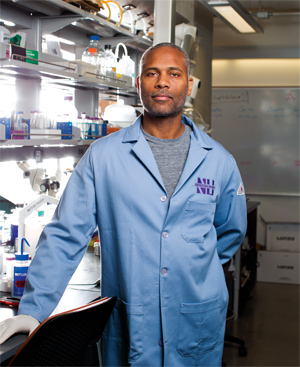The Other Side of O2
New biomaterial promotes surgical healing
Human beings in general think of oxygen as a good thing. We can’t survive without it. But this life-sustaining molecule has a dark side, and Guillermo Ameer is out to stop it from wreaking havoc inside the human body.
 “When surgeons place a medical device or implant inside the body, there’s always an inflammatory response,” says Ameer, professor of biomedical engineering in the McCormick School of Engineering and professor of surgery in the Feinberg School of Medicine. “In addition to that inflammatory response, with commonly used plastic materials, oxidation occurs.”
“When surgeons place a medical device or implant inside the body, there’s always an inflammatory response,” says Ameer, professor of biomedical engineering in the McCormick School of Engineering and professor of surgery in the Feinberg School of Medicine. “In addition to that inflammatory response, with commonly used plastic materials, oxidation occurs.”
A high concentration of oxygen in the body can cause oxidative reactions to fall out of balance, which modifies natural proteins, cells, and lipids, causing them to function abnormally. This oxidative stress is toxic and can contribute to chronic disease, chronic inflammation, and other complications that may cause surgical implants to fail.
Stopping the toxic domino effect in its tracks
Ameer has created a biodegradable biomaterial that is inherently antioxidant. Biomedical engineers can use this material to create elastomers, liquids, gels, or solids for building devices that are more compatible with cells and tissues.
“Implants made from plastics can self-oxidize, creating free radicals as part of their degradation process,” Ameer says. “The oxidation process can injure nearby cells and create a cascade effect that leads to chronic inflammation. Our material could significantly reduce the inflammatory response.”
Ameer created the biomaterial, a polyester based on citric acid, by incorporating vitamin C into its building blocks. In preliminary experiments, his team coated vascular grafts with the antioxidant biomaterial. The grafts were then evaluated in animals by Ameer’s long-time collaborator Melina Kibbe, professor of surgery, the Edward G. Elcock Professor of Surgical Research at Feinberg, and a vascular surgeon at Northwestern Memorial Hospital.
Typical of the foreign body response, grafts tend to inflame nearby cells and slowly cause tissue to scar over time, which eventually leads to failure. When the antioxidantcoated vascular graft was implanted, however, scarring was significantly reduced. Ameer’s team, funded by a proof-of-concept grant from the Northwestern University Clinical and Translational Sciences Institute, also found that a watersoluble, thermoreversible version of the material sped up the healing of diabetic ulcers. Because the material is biodegradable, the body harmlessly absorbs it over time.
“In the past, others have added antioxidant vitamins to a polymer and blended it in,” Ameer says. “That can affect the mechanical properties of the material and limit how much antioxidant you can add, so it doesn’t work well. What we’re doing is different. We’re building a material that is already inherently, intrinsically antioxidant.”
Exploring new uses
Ameer says the new biomaterial could be used to create scaffolds for tissue engineering, coat or build safer medical devices, promote healing in regenerative medicine, and protect cells, genes, and viruses during drug delivery. He adds that the new biomaterial is easy to make and inexpensive.
“Citric acid is affordable and in pretty much everything we come in contact with on a daily basis—food and beverages, skin and hair products, drugs, you name it,” Ameer says. “It’s a common, inexpensive raw material, and the human body can stabilize vitamin C, an antioxidant that we’re all familiar with.”
